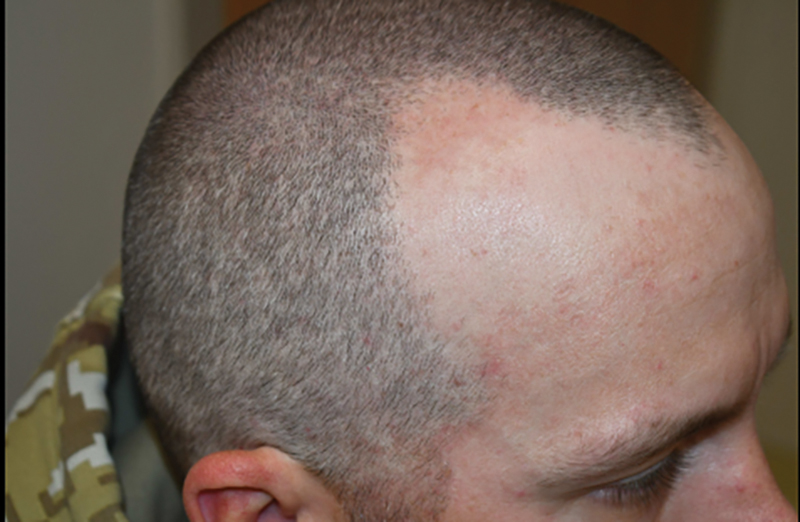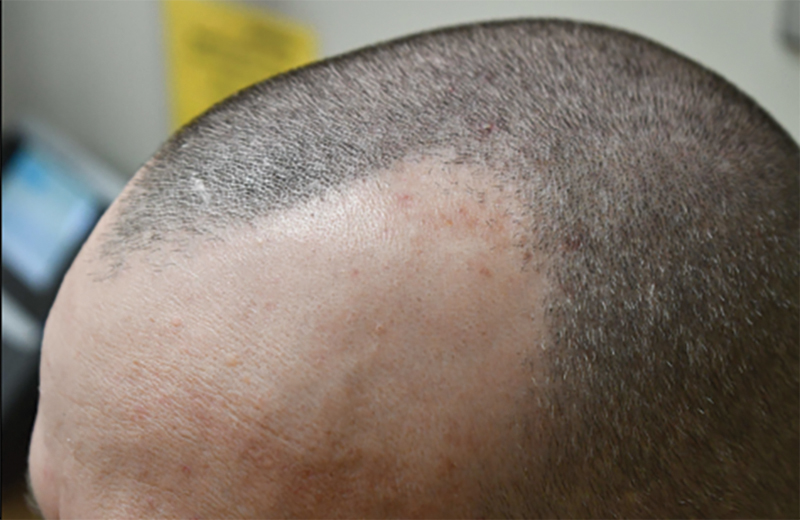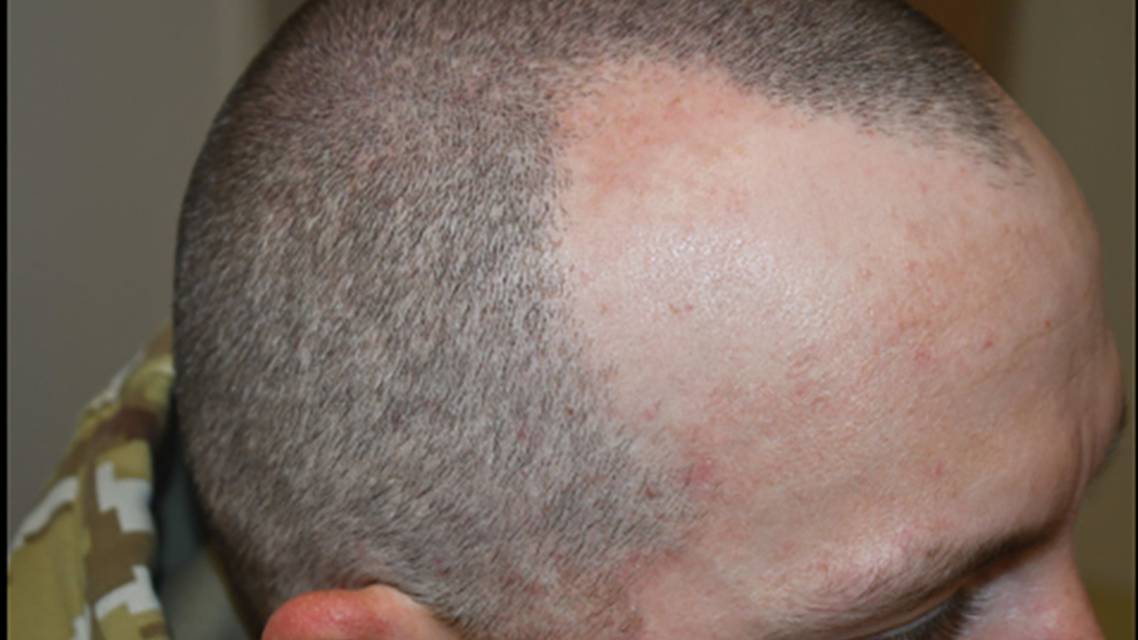Melasma is the deposition of melanin within the epidermis or dermal macrophages. Classically, Hispanic and Asian females, those in their 3rd and 4th decades of life, those utilizing oral contraceptives, individuals in their third trimester of pregnancy, and those with darker skin tones have shown to be at an increased risk of acquiring melasma.1 Studies have speculated that the onset of melasma aligns with the increase in estrogen production during pregnancy and have shown that progesterone stimulates melanogenesis in epidermal melanocytes.2 For these reasons, one of the pathological causes for melasma is thought to be hormone-based, especially as it relates to progesterone and estrogen. Other explanations include photoaging, inflammation, cosmetics, and steroid use.3 These explanations highlight the complex, multifactorial etiologies of melasma, many of which are still not known or fully understood.
Few studies have focused on the etiology of melasma in men, which are approximately 10% of the total population affected by melasma.4 Some studies highlighted an elevated luteinizing hormone (LH) and decreased testosterone in males with melasma when compared to a controlled, matched group.5 A small portion of these men have reported to be on testosterone supplementation to combat their decreased testosterone levels. Though the supplementation of testosterone may contribute to the formation of melasma by being further aromatized to estradiol as estradiol increases the level of melanogenic enzyme, especially TRP-2 in normal human melanocytes, it is unclear if solely low levels of testosterone may cause this condition.6 This case study discusses orchiectomy, and subsequent changes in hormones, as a possible etiology of melasma in men.
Case Presentation
The patient was a 36-year-old male who presented to the dermatology clinic with a chief complaint of a rash on his forehead, which began approximately 4 to 5 months following an orchiectomy that was performed following a diagnosis of giant cell tumors of the scrotum. He reported minimal sun exposure as he typically remained indoors and consistently wore a hat that covered his forehead down to his eyebrows. The patient reported neither a personal nor family history of melasma. Upon evaluation during the initial visit, the patient was diagnosed with melasma. The onset of melasma post-orchiectomy was considered pathophysiologically plausible due to potential hormonal changes, specifically decreased testosterone levels. Differential diagnoses such as Addison’s disease were considered less likely given the characteristic distribution of the rash and well-demarcated linear cutoff across the forehead, corresponding to the area where his hat would sit. Laboratory investigations including complete blood count (CBC), comprehensive metabolic panel (CMP), and thyroid-stimulating hormone (TSH) were reassuring, with no abnormalities detected. The patient’s medical history was notable for hypertension but did not suggest adrenal insufficiency. Given the chronic and active nature of melasma, treatment options including tretinoin, azelaic acid, and hydroquinone were discussed, with the patient expressing interest in initiating tretinoin therapy.
Initial Treatment Plan
Initiation of tretinoin 0.025% cream once daily at bedtime, with instructions to taper up slowly and use a moisturizer to minimize irritation, was prescribed with an emphasis on strict photoprotection measures.
8-Month Follow-Up
Upon reassessment, the patient’s dermatological problem list included “Melasma, status post-orchiectomy.” The melasma had shown mild improvement with tretinoin therapy; however, it continued to significantly impact the patient’s quality of life, leading to anxiety and social withdrawal. Given these concerns, a more intensive treatment approach was proposed:
- Upgraded tretinoin strength to 0.05% cream once daily at bedtime.
- Addition of hydroquinone 4% cream once daily in the morning for a duration of 3 months, followed by a 2-month break. During the breaks, azelaic acid 20% cream was recommended for morning use.
- Future plans included potential escalation of hydroquinone and tretinoin concentrations.
- Emphasis on continued strict photoprotection measures.




Images: Photographs of a male patient's melasma prior to treatment.
Discussion
This case underscored the challenge of managing melasma in male patients post-orchiectomy. While the exact pathophysiological mechanisms remain unclear, the hormonal alterations associated with orchiectomy may contribute to the development of melasma.
Melasma, a common acquired hyperpigmentation disorder, predominantly affects women. The etiology of melasma is multifactorial, involving genetic predisposition, hormonal influences, ultraviolet (UV) radiation exposure, and various other factors. Hormonal factors, particularly estrogen and progesterone, play a significant role in the pathogenesis of melasma, with pregnancy, oral contraceptive use, and hormone replacement therapy being well-established triggers.2,7
The occurrence of melasma in men is relatively rare and often associated with specific predisposing factors such as exogenous estrogen exposure, sun exposure, and genetic susceptibility.4 In contrast to women, the hormonal influence in men is primarily attributed to testosterone rather than estrogen and progesterone. Therefore, the occurrence of melasma in men, especially in the absence of exogenous hormonal influences, is considered atypical and warrants thorough investigation.
In the case presented, the development of melasma in a male patient post-orchiectomy adds an intriguing dimension to its rarity. Orchiectomy, or surgical removal of one or both testicles, results in a significant decrease in testosterone production, which may lead to hormonal imbalances.8 Testosterone, through its conversion to dihydrotestosterone (DHT), exerts various effects on the skin, including regulation of sebum production, hair growth, and melanogenesis.9
The association between testosterone levels and melasma development remains controversial, with conflicting evidence regarding the role of androgens in hyperpigmentation disorders.5-6 However, some studies suggest that testosterone and DHT may influence melanocyte activity and melanin synthesis, potentially contributing to the pathogenesis of melasma.5
The development of melasma post-orchiectomy in the presented case raises intriguing questions about the interplay between hormonal alterations and cutaneous manifestations. While the exact mechanisms underlying this association remain unclear, it underscores the importance of considering hormonal factors in the evaluation and management of melasma, particularly in atypical cases such as this.
Further research is warranted to elucidate the specific hormonal pathways involved in melasma pathogenesis in men, particularly in the context of testosterone deficiency post-orchiectomy. While the influence of testosterone on melanogenesis requires more exploration, studies suggest its potential role through its conversion to DHT.1 Additionally, orchiectomy results in changes in other hormones such as LH and follicle-stimulating hormone (FSH), whose potential impact on melasma development needs further investigation.7
Prospective studies investigating the prevalence and clinical characteristics of melasma in male patients undergoing hormonal interventions, such as orchiectomy, are needed to enhance our understanding of this intriguing dermatological phenomenon. Such studies could shed light on risk factors and the timeline of melasma development in this unique context.
Treatment strategies focusing on topical agents such as tretinoin, hydroquinone, and azelaic acid, along with diligent photoprotection, are essential in mitigating the impact of melasma on patients’ lives.2,3 Further research is warranted to elucidate the interplay between hormonal changes and cutaneous manifestations in this population, potentially leading to the development of more targeted therapies.
Conclusion
The case highlights the significance of considering melasma in male patients post-orchiectomy and underscores the importance of tailored treatment approaches to address the complex nature of this dermatological condition. Further studies are needed to explore the underlying mechanisms and optimal management strategies in this unique patient population.
Disclosure: The authors reported no relevant financial relationships.
Consent: Informed consent was obtained from the patient for publication of this case report. Ethical and institutional permissions were obtained.
Teekz Yenpasook, DO, is a resident dermatology physician at the University of Minnesota.
Christian Brian Caddali, BS, is an osteopathic medical student at Western University of Health Sciences – College of Osteopathic Medicine of the Pacific in Pomona, CA.
1. Handel AC, Miot LD, Miot HA. Melasma: a clinical and epidemiological review. An Bras Dermatol. 2014 Sep-Oct;89(5):771-82. doi: 10.1590/abd1806-4841.20143063.
2. Videira IF, Moura DF, Magina S. Mechanisms regulating melanogenesis. An Bras Dermatol. 2013 Jan-Feb;88(1):76-83. doi: 10.1590/s0365-05962013000100009.
3. Grimes PE, Ijaz S, Nashawati R, Kwak D. New oral and topical approaches for the treatment of melasma. Int J Womens Dermatol. 2018 Nov 20;5(1):30-36. doi: 10.1016/j.ijwd.2018.09.004.
4. Achar A, Rathi SK. Melasma: a clinico-epidemiological study of 312 cases. Indian J Dermatol. 2011 Jul;56(4):380-2. doi: 10.4103/0019-5154.84722.
5. Lee DJ, Lee J, Ha SJ, et al. Male melasma: a retrospective study of clinical features and hormonal profiles. J Eur Acad Dermatol Venereol. 2021;35(11):2298-2305.
6. Kang HY, Ortonne JP. What should be considered in treatment of melasma. Ann Dermatol. 2010 Nov;22(4):373-8. doi: 10.5021/ad.2010.22.4.373. Epub 2010 Nov 5.
7. Sarkar R, Arora P, Garg VK. Melasma update. Indian Dermatol Online J. 2014 Oct;5(4):426-35.
8. Wiechno PJ, Kowalska M, Kucharz J, Sadowska M, Michalski W, Poniatowska G, Jońska-Gmyrek J, Rzymkowska J, Nietupski K, Demkow T. Dynamics of hormonal disorders following unilateral orchiectomy for a testicular tumor. Med Oncol. 2017 May;34(5):84. doi: 10.1007/s12032-017-0943-0. Epub 2017 Apr 7.
9. Deplewski D, Rosenfield RL. Role of hormones in pilosebaceous unit development. Endocr Rev. 2000 Aug;21(4):363-92.




